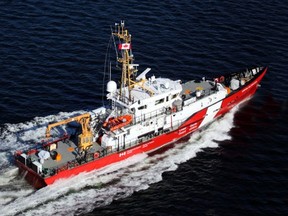The Short Life of CCGS Corporal McLaren

The CCGS Corporal McLaren M.M.V, a Canadian Coast Guard vessel, had a brief and troubled existence. Built at a staggering cost of $21.6 million, it served for only five years before being deemed surplus and set for scrapping. The vessel’s downfall was not due to wear and tear but rather an act of vandalism that led to its premature demise. This article delves into the history of the Corporal McLaren, its operational challenges, and the circumstances surrounding its untimely end.
Construction and Initial Challenges
The CCGS Corporal McLaren was one of nine Hero-Class patrol vessels commissioned by the Canadian Coast Guard. The fleet was intended to bolster maritime security and enforce fishing regulations in Canadian waters. The construction of these vessels took place at Irving Shipyards in Halifax, Nova Scotia, under a $194 million contract awarded in 2009. The first vessel was launched in 2012, with the last one entering service in 2014.
Despite the initial excitement surrounding the project, the vessels faced significant challenges from the outset. Concerns about their design emerged even before construction began. Issues such as water flow between compartments and stability problems were identified. These concerns were not adequately addressed during the design and construction phases, leading to ongoing operational difficulties.
The Corporal McLaren was launched in October 2013, measuring 43 meters in length and designed to operate in harsh marine environments. However, the vessel’s operational life was marred by corrosion issues, particularly in the stern. This corrosion led to its removal from service in May 2016 for repairs. The vessel’s construction had promised local economic benefits, including job creation and contracts for local suppliers, but the ongoing issues raised questions about the project’s overall success.
The Vandalism Incident and Aftermath
The most significant blow to the CCGS Corporal McLaren came in 2018 when it was vandalized while docked at the Bedford Institute of Oceanography in Dartmouth, Nova Scotia. During this incident, vandals cut the iron cables that secured the vessel, causing it to slide into the icy waters of the Atlantic Ocean. The Halifax Police treated the incident as suspicious, suggesting that it was not the work of amateurs. Unfortunately, the mystery of the vandalism remains unsolved, and the perpetrators were never caught.
The damage inflicted by the vandals was extensive. The Coast Guard estimated that the incident resulted in approximately $14 million worth of damage. The vessel partially submerged, leading to water filling several compartments and damaging critical computer equipment and wiring. Initially, the government allocated $11 million for repairs, but the extent of the damage quickly escalated the costs.
In the wake of the incident, the Coast Guard severed ties with Canadian Maritime Engineering, the shipyard responsible for the repairs at the time of the vandalism. Despite this, the government later awarded a contract to the same company for a separate drydock project. The situation raised eyebrows and questions about accountability and oversight in the management of public contracts.
Final Days and Scrapping
After the vandalism incident, the fate of the CCGS Corporal McLaren was sealed. Although efforts were made to refloat the vessel, it was ultimately deemed surplus and unworthy of repair. In June 2024, a tender was issued for scrapping the damaged ship. The Canadian Coast Guard awarded a contract worth $412,000 to Marine Recycling Corporation for the dismantling and recycling of the vessel.
The Corporal McLaren’s story is a cautionary tale about the complexities of managing large-scale public projects. Built with high hopes and significant investment, it served only five years before being reduced to scrap. The incident highlights the importance of robust security measures and the need for thorough oversight in public contracts. As the Canadian Coast Guard moves forward, the lessons learned from the Corporal McLaren’s brief existence will undoubtedly influence future projects and investments in maritime security.
